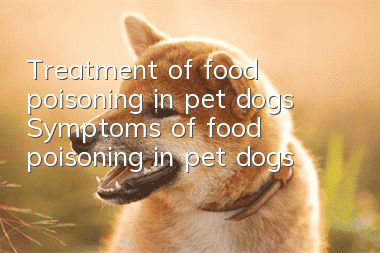Treatment of food poisoning in pet dogs Symptoms of food poisoning in pet dogs

Methods for disposal after pet poisoning
1. Prevent further absorption of the drug. This is the earliest and most important step. The flushing method can be used. If the poison is absorbed through the skin, rinse the skin and coat of the affected dog repeatedly with clean water, or put it into a bathtub for soaking. When cleaning, people should wear waterproof gloves and scrub gently.
(1) Vomiting: It is a first-aid measure to expel the poison that has entered the stomach from the body. It works very well over a short period of time when the poison is taken into the body. If you take the medicine for more than 4 hours, most of the poison will enter the duodenum, so emetics cannot be used.
②Gastric lavage: Use gastric lavage when vomiting cannot be induced or when vomiting cannot be effective. It is effective when used within 2 hours of poison ingestion. It can discharge gastric contents, adjust pH, relieve gastric wall stimulation and pyloric sphincter spasm, and restore gastric peristalsis and secretion functions. This method can also be used for acute gastric distension. Commonly used are warm salt water, warm boiled water, 1%-2% NaCl solution, warm soapy water, strong tea and 1% soda solution. The amount of gastric lavage liquid is 5 to 10 ml per kilogram of body weight, and the gastric lavage liquid is washed repeatedly. Adding 0.02%-0.05% activated carbon to the gastric lavage liquid can enhance the gastric lavage effect.
③Adsorption method: Use adsorbents such as activated carbon to adsorb poisons on the surface of the medicine, thereby effectively preventing poison absorption. However, it should be noted that plant-based activated carbon should be used to treat poisoning, and do not use mineral or animal-based activated carbon. 30 minutes after taking activated charcoal, you should take laxatives, combined with inducing vomiting or gastric lavage, for better efficacy. But activated carbon is not effective against cyanide poisoning.
④Laxatives: Another way to promote the discharge of poisons from the gastrointestinal tract. Be careful not to use vegetable oil, because the poisons can be dissolved in them and prolong the poisoning time.
Diuretics can speed up the removal of absorbed poisons
Accelerate the removal of absorbed poisons. Diuretics can speed detoxification but should be administered when the pet's water, electrolytes, and kidney function are normal. Furosemide and mannitol are commonly used. During use, if no increase in urine output is observed, repeated use should be prohibited. After treatment, intravenous fluids can prevent dehydration.
Changing the pH of urine can speed up the elimination of toxins. Oral administration of NH4Cl can acidify urine, and soda can make urine alkaline to treat poisoning by weakly acidic compounds, such as aspirin and barbiturate poisoning.
- Is it better for Dogo dogs to have their ears erect or cropped? A case of Dogo dog’s ear erection surgery will tell you
- What do dogs eat to protect their stomach? It is important to protect their stomach and treat gastrointestinal diseases in dogs.
- How to tell if your dog is fat? Is your dog overweight?
- Will your dog catch a cold if you blow the air conditioner? What should you do if your dog catches a cold if you blow the air conditioner?
- What should you pay attention to when your dog drinks water? Don’t be careless when it comes to your dog’s drinking water.
- The dog's mouth bites and shakes. Why does the dog's mouth occasionally shake and bite?
- How to cut a dog's hair? Do you know how to cut a dog's hair correctly?
- Can dogs eat raw eggs? Why can’t dogs eat egg whites?
- Common Dog Problems in Summer How to Deal with Different Dog Problems
- How to keep dogs away from skin diseases. If you do this, will you see if your dog will still be infected with skin diseases?



